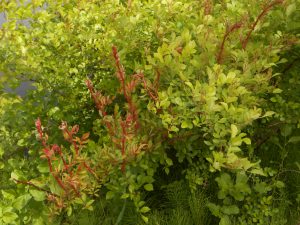Rose Rosette Disease
Views: 6782

Last Monday morning, Bob and I decided to take a walk down by the Farmington River. Our little town of Windsor, Connecticut has beautiful, paved walking trails to take a lovely walk in the woods. Windsor’s River Trail begins behind the town center, just over the railroad tracks. There is a lovely pond to walk past before walking over the bridge that leads into the woods by the river. On this particular morning, we were greeted by a basso-profundo bull frog that was really making a racket!! Bob went over to the water’s edge to see if he could spot him. My eyes followed Bob walking past several rosa multiflora plants on his way to the pond when what I saw made me stop in shock! Rose Rosette Disease.
Rose Rosette Disease
Take a good look at the picture I have posted with this blog. See the red, deformed stems and foliage on these wild roses? This is the dreaded ‘Rose Rosette Disease.’ Right here in River City.
Rose Rosette Disease is vectored by a tiny mite called an eriophyiid mite. It carries the disease in its mouthparts and infects roses while feeding. This mite is so small that it makes garden-variety two-spotted spider mites look like buffalo. It spreads by blowing long distances in the wind. I suspect birds may carry them in their feathers, too, as they love to eat r. multiflora seeds. These little mites are especially attracted to r. multiflora. They can blow into your cultivated roses and spread the disease to them, too.
Discovery
I discovered Rose Rosette Disease at the Elizabeth Park Rose Garden back in the summer of 2009. That discovery came with the same feeling of shock I felt last Monday. I had never seen the disease before but I had been reading about it for years. I called my friends John Mattia and Mike Fuss and Dr. Jim LaMondia, who is a fabulous scientist and plant pathologist at our Valley Lab Agricultural Station.
The plant in question was an old garden rose rambling on the fence line. It had finished blooming, the gardeners had cut it back. When it began to regrow, it was covered with weird-looking stems that were hyper-prickled. The foliage looked like it had been sprayed with Round-Up. All the new growth was terribly distorted.
Up until that point, no one knew that Rose Rosette Disease (RRD) was in Connecticut. Because it had never been here before, Jim LaMondia needed to read up on it. He suggested because of the terrible symptoms that we cut back and rogue out the plant. Then to put it in black plastic bags and send it to the incinerator. He also suggested, because the plants at the park are planted so close to each other, that we rogue out the roses on either side, as well, and leave the ground fallow until the next spring.
Spraying Roses with Miticides
Last summer, my friend Baldo Villegas found RRD on the r. multiflora on our neighbor’s property. I also had a suspicious couple of plants in my yard last spring which I rogued out. Later on in the summer another rose bush in my garden, ‘Whisper,’ became symptomatic.
I alternated Floramite and Forbid (newer miticides, as the eriophyiid mites are resistant to many miticides) whenever I sprayed last summer in case there were any eriophyiid mites blowing around. Because I was pretty sure I had demolished all the mites, I left ‘Whisper’ in the garden until this spring. After several weeks of growing, it threw a couple suspicious stems, so I cut it back, dug it out, and sent it to the dump in a black plastic bag.
This winter, our neighbors took out all the r. multiflora at the bottom of our hill. (What wonderful neighbors!) This is your first line of defense against RRD because the tiny mites seem to prefer r. multiflora to other roses. R. multiflora is on the noxious weed list because each tiny bloom turns into a small red hip full of seeds. The birds gobble them up and subsequently spread r. multiflora far and wide in their droppings and every seed germinates!
Disease
These roses were brought here from Asia during the great depression to try to hold back the dust bowl in our stricken midwest. They did help to hold the soil but they have spread everywhere throughout these United States. Not everyone is upset about RRD. Many farmers are happy that this disease is killing these wild roses that are so out of control on their farm land.
It’s very hard to talk about a disease like this. There is no cure for it yet, but Texas A&M University has a team headed by David Byrne that is studying this disease. There are volunteers such as myself that are on the look out for it so we can check out where it is spreading. I just remember that knowledge is power. The more we learn the closer we will get to stopping this awful disease in its tracks.
If you suspect that you have RRD in your garden, please take a cutting in a sealed plastic bag to your local ag station to report it. Then, rogue the plant out, put it in a black plastic bag and take it to the dump like I did. Also, join the American Rose Society. The American Rose magazine has many articles on RRD, and as progress is made in finding a cure, I’m sure it will be posted there first…which will be a major relief to rosarians from sea to shining sea.
Meet Marci Martin
Marci Martin has loved roses for as long as she can remember. From the time she was a little girl, she was fascinated with how…
Marci's Recent Posts

March: An Early Start in the Rose Garden This Year








